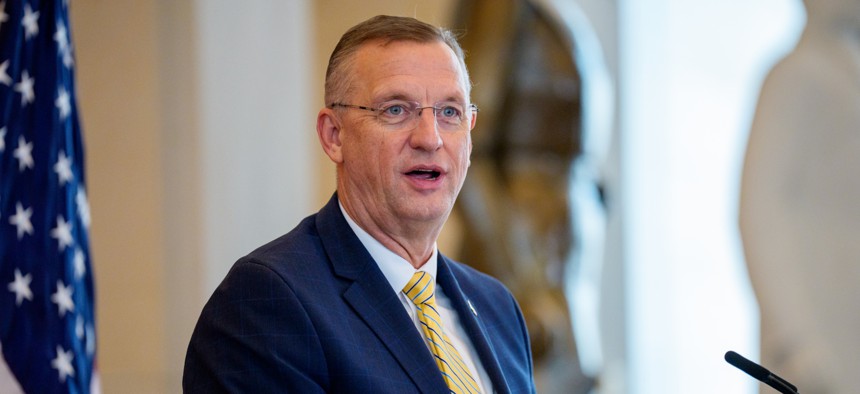
Veterans Affairs Secretary Doug Collins said a "department-wide RIF is off the table," but VA officials noted that more targeted layoffs could still be an option. Andrew Harnik / Getty Images
VA backs down on mass layoffs, will cut 30K through attrition only
Following significant pushback, VA is reversing course on its plan for widespread RIFs while still promising some staffing reductions.
Updated July 7 at 5:30 p.m.
The Veterans Affairs Department will shed 30,000 total employees by the end of September and use only attrition to do so, the agency announced on Monday, reversing course from its previous goal of shedding nearly three times that number and relying on involuntary layoffs.
VA has already shed 17,000 employees since January, and plans to cut another 12,000 through additional attrition and separation incentives including early retirement offers and “deferred resignations” that allow employees to take paid leave for months before exiting government. Some parts of the department remain under a hiring freeze.
VA previously told top-level staff it would utilize widespread reductions in force to cut its workforce back to the level it employed in fiscal 2019, leading to a reduction of more than 80,000 employees and a rollback of all the hiring that had taken place to support the veterans newly eligible for department care after the passage of the 2022 PACT Act. Secretary Doug Collins confirmed that plan following Government Executive’s reporting, but subsequently told lawmakers the proposal was still in flux and could be changed.
“Since March, we’ve been conducting a holistic review of the department centered on reducing bureaucracy and improving services to veterans,” Collins said on Monday. “As a result of our efforts, VA is headed in the right direction—both in terms of staff levels and customer service. A department-wide RIF is off the table, but that doesn’t mean we’re done improving VA.”
While VA said it would not implement a "large-scale" or "department-wide" RIF, it did not rule out using more targeted layoffs. Pete Kasperowicz, a department spokesperson, clarified, however, that there would not be any reductions beyond the 30,000 currently planned.
The original plan was met with widespread concern and some bipartisan pushback. VA was until recently still moving forward with its RIF plans, even signing a $700,000 contract with the Office of Personnel Management for assistance in the mass layoff process. The department stood up a Reorganization Implementation Cell, made up of senior leaders throughout VA, which has continued to meet and receive varying instructions from political appointees over the RIF plans.
VA has until Monday kept its plans under wraps, requiring all of those working on it to take the unusual step of signing a non-disclosure agreement.
One VA executive who served on the implementation cell said recent meetings have focused more on reorganization efforts rather than layoffs and workforce reduction.
Rep. Mike Bost, R-Ill., who chairs the House Veterans Affairs Committee, praised Monday’s announcement and said any prior criticism was premature.
“From the very beginning I have long said that I had full confidence in Secretary Collins and the Trump administration to make the right decision surrounding any plans to reduce VA’s workforce,” Bost said. “With today’s announcement from Secretary Collins, those who have spent the last six months yelling from the sidelines should have held off their criticism of potential plans until a plan was actually in place.”
The American Federation of Government Employees council that represents employees in VA’s central office, however, suggested the change was a direct result of outcry and pushback. The group said the change in plans was not “a coincidence, it was a response.” The union added significant damage has been done to the VA workforce.
“What Secretary Collins fails to understand is that while his plan may be shrinking the headcount, it’s also leaving behind a workforce that is angry, resentful, and—worst of all—disengaged,” the union said. “You can cut positions, Mr. Secretary, but you can’t gut morale and expect the mission to survive.”
Sen. Richard Blumenthal, D-Conn., and Rep. Mark Takano, D-Calif., the top Democrats on the Senate and House Veterans Affairs Committees, respectively, said in separate statements the cuts would have a devastating impact on VA and were the result of intention efforts to shed staff rather than natural attrition.
“This announcement makes clear VA is bleeding employees across the board at an unsustainable rate because of the toxic work environment created by this Administration and DOGE’s slash and trash policies," Blumenthal said. "It is shameful, and it will continue to ruin veterans’ trust in VA for years to come.”
Going forward, VA said it is "exploring a number of additional reforms" to improve operations at VA. That may include centralizing support functions so the Veterans Health Administration, Veterans Benefits Administration and National Cemetery Administration no longer run "duplicative and costly" administrative operations. It could also include pooling together functions such as procurement, IT and budgeting, similar to an effort recently undertaken at the Interior Department and expected at some other major agencies as well.
The department is also looking to consolidate its 274 call centers and is in the process of centralizing its payroll processing so individual hospitals do not have to carry out those functions.
This story has been updated with additional comment.
Share your news tips with us:
Eric Katz: ekatz@govexec.com, Signal: erickatz.28
NEXT STORY: 3 injured during a gunfight at a Border Patrol building in Texas







